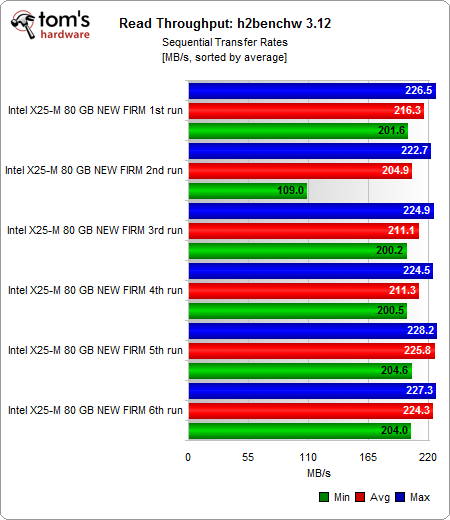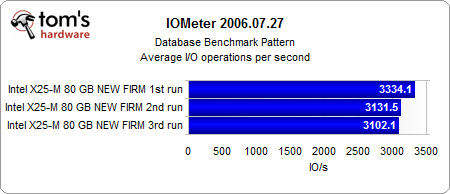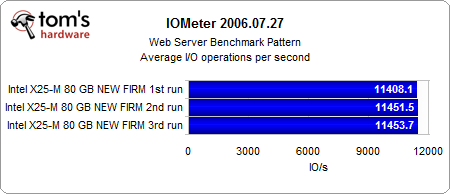The SSD Workload Performance Analysis
Intel X25-M Mainstream Flash SSD With Firmware Update
Throughput Testing
Do you remember read performance crashing to 42 MB/s with the old firmware? Intel’s engineers did a great job in optimizing the firmware, as the read throughput didn’t decrease significantly any more with the new 8820 firmware. The minimum throughput after the first h2benchw/IOMeter cycle was 109 MB/s, but after just the second cycle the X25-M was able to adjust and maintain a minimum sequential read throughput of 200 MB/s.
Although the firmware update cannot prevent minimum write throughput decreasing to only a few megabytes per second, the maximum results stay at a constant 80 MB/s, while the average numbers even keep increasing. Clearly, the firmware adjusts to the workload much more efficiently.
I/O Testing
There still is a little performance drop, but the 8820 firmware manages to buffer the drop significantly. A decrease from 3,300 to 3,100 I/O operations per second for typical database transactions is certainly acceptable.
The extreme performance differences of the 8160 firmware are gone with version 8820, but the fileserver performance keeps increasing.
Web server performance doesn’t suffer from the heavily changing torture testing with the new firmware, as the X25-M reaches 11,400 I/O operations per second in the Web server test at all times.
Get Tom's Hardware's best news and in-depth reviews, straight to your inbox.
Workstation performance, which is based on small to medium block sizes, is different now. Although the first run results in less I/O performance than was the case on the old firmware, the following runs actually are much better.
Overall, the new 8820 firmware for the X25-M offers a significant improvement over the old 8160 version, as it manages to maintain performance at a higher level than was possible before. Both throughput and I/O performance are more predictable and closer to the maximum results. Compared to the performance increases caused by driver or firmware updates on graphics cards or for processors and platforms, the improvements here are much more significant.
Current page: Intel X25-M Mainstream Flash SSD With Firmware Update
Prev Page Intel X25-M Mainstream Flash SSD (80 GB) Next Page Intel X25-E Professional Flash SSD (32 GB)




